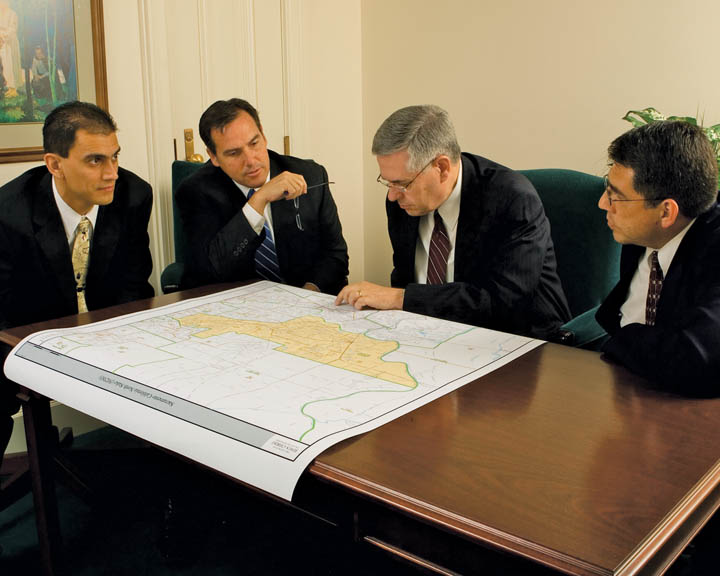Difference between revisions of "Branch President"
| Line 1: | Line 1: | ||
| − | [[image:Mormon Bishopbric.jpg|thumb|right|300px|alt=Mormon Bishopric]]A '''branch president''' is the authority over a [[Branch]] of the Church. He usually holds the [[Melchizedek Priesthood]], but if no worthy man is available, a worthy priest (holding the [[Aaronic Priesthood]]) may be called and set apart. | + | [[image:Mormon Bishopbric.jpg|thumb|right|300px|alt=Mormon Bishopric]]A '''branch president''' is the authority over a [[Branch]] of the Church. He usually holds the [[Melchizedek Priesthood]], but if no worthy man is available, a worthy [[Priest|priest]] (holding the [[Aaronic Priesthood]]) may be called and set apart. |
| − | A branch president has many duties similar to a [[Bishop|bishop]]. He is the presiding priesthood leader and the common judge, and directs the care for the poor and needy. He oversees the quorums, auxiliaries, meetings and activities in the branch, with an emphasis on the young women and Aaronic priesthood young men. He extends calls to members to serve in various branch positions and interviews quorum and auxiliary leaders regularly to counsel with them and receive their reports on their stewardships. If the branch president holds the Melchizedek priesthood, he also oversees finances and records until a clerk can be called. The clerk follows Church policy on the handling of Church funds. | + | A branch president has many duties similar to a [[Bishop|bishop]]. He is the presiding priesthood leader and the common judge, and directs the care for the poor and needy. He oversees the quorums, auxiliaries, meetings and activities in the branch, with an emphasis on the [[Young Women|young women]] and Aaronic priesthood [[Young Men|young men]]. He extends calls to members to serve in various branch positions and interviews quorum and auxiliary leaders regularly to counsel with them and receive their reports on their stewardships. If the branch president holds the Melchizedek priesthood, he also oversees finances and records until a clerk can be called. The clerk follows Church policy on the handling of Church funds. |
A branch is a small congregation in the Church, with usually less than two hundred members. Branches may be found in stakes, typically in outlying communities where a smaller number of Church members live, or in larger areas where a small number of members are isolated due to language and prefer to meet together rather than join a larger congregation that does not speak their language. | A branch is a small congregation in the Church, with usually less than two hundred members. Branches may be found in stakes, typically in outlying communities where a smaller number of Church members live, or in larger areas where a small number of members are isolated due to language and prefer to meet together rather than join a larger congregation that does not speak their language. | ||
Revision as of 18:26, 24 October 2018
A branch president is the authority over a Branch of the Church. He usually holds the Melchizedek Priesthood, but if no worthy man is available, a worthy priest (holding the Aaronic Priesthood) may be called and set apart.
A branch president has many duties similar to a bishop. He is the presiding priesthood leader and the common judge, and directs the care for the poor and needy. He oversees the quorums, auxiliaries, meetings and activities in the branch, with an emphasis on the young women and Aaronic priesthood young men. He extends calls to members to serve in various branch positions and interviews quorum and auxiliary leaders regularly to counsel with them and receive their reports on their stewardships. If the branch president holds the Melchizedek priesthood, he also oversees finances and records until a clerk can be called. The clerk follows Church policy on the handling of Church funds.
A branch is a small congregation in the Church, with usually less than two hundred members. Branches may be found in stakes, typically in outlying communities where a smaller number of Church members live, or in larger areas where a small number of members are isolated due to language and prefer to meet together rather than join a larger congregation that does not speak their language.
A branch is organized by a mission or district president who also confer the keys of presidency on the branch president, which keys permit him to administer the Lord’s work in the branch. A branch president “watches over and strengthens the members, visits their homes often as a [ministering brother], conducts sacrament meetings, directs branch activities, and completes reports.”[1]
The mission or district president may call counselors under the guidance of the Spirit of the Lord when more men in the branch receive the priesthood. Those three men would constitute a branch presidency.
